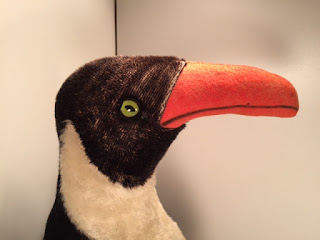"I was hoping you could tell me a bit more about a Steiff tiger that I found recently. It is similar to one you've written a blog post about already but with some noticeable differences. It is an approximately 40 cm long, 23 cm tall mohair tiger wearing a black felt vest with an orange "Princeton" P. It has a Steiff button in the ear and a tag that says "US Zone Germany." It is standing, rather than sitting and does not have a jointed head as the one you've written about did. However, it does have the "cartoon" eyes."
 Wow, Steiffgal is seeing stripes over this cool cat. This indeed is the standing, larger version of Steiff's early 1950's Princeton Tiger. He is unjointed and made from mohair that has been hand airbrushed with black stripes. His face comes to life with a prominent, felt lined open mouth, white wooden teeth, and green and black "squint" style glass eyes. And, of course, what makes him head of the class is his orange and black felt "P" blanket. He was made as an exclusive for the upscale US toy retailer F.A.O. Schwarz in the c. 1951-1952 timeframe.
Wow, Steiffgal is seeing stripes over this cool cat. This indeed is the standing, larger version of Steiff's early 1950's Princeton Tiger. He is unjointed and made from mohair that has been hand airbrushed with black stripes. His face comes to life with a prominent, felt lined open mouth, white wooden teeth, and green and black "squint" style glass eyes. And, of course, what makes him head of the class is his orange and black felt "P" blanket. He was made as an exclusive for the upscale US toy retailer F.A.O. Schwarz in the c. 1951-1952 timeframe. Now let's take a little trip backwards in time and check out some interesting things about this grrrr-eat example. Here you can see this tiger's original advertising from the 1951 F.A.O. Schwarz catalog. Other Steiff mascots listed with him include the sitting Princeton Tiger, a sitting and standing Yale Bulldog, a sitting and standing Navy Goat, an Army Mule, and a Columbia Lion. They ranged in price at the time from $7.50-10.00. This is the equivalent of $69.62 to $92.83 in 2016 dollars. Steiff is, and always has been, a premium product. Ironically, the mascots pictured just below the Steiff versions that were made in France are more expensive than the Steiff ones upon their introduction. It is Steiffgal's strongest suspicion that they would have mostly sentimental value today.
Now let's take a little trip backwards in time and check out some interesting things about this grrrr-eat example. Here you can see this tiger's original advertising from the 1951 F.A.O. Schwarz catalog. Other Steiff mascots listed with him include the sitting Princeton Tiger, a sitting and standing Yale Bulldog, a sitting and standing Navy Goat, an Army Mule, and a Columbia Lion. They ranged in price at the time from $7.50-10.00. This is the equivalent of $69.62 to $92.83 in 2016 dollars. Steiff is, and always has been, a premium product. Ironically, the mascots pictured just below the Steiff versions that were made in France are more expensive than the Steiff ones upon their introduction. It is Steiffgal's strongest suspicion that they would have mostly sentimental value today.Steiff also created other smaller scaled school and institutional mascots in the late 1950's and early 1960's. These were all standing and included a 14 cm Yale Bulldog in 1957, a 10 cm Princeton Tiger in 1957-1958, 12 and 14 cm Army Donkeys in 1957, a 15 cm Navy Goat in 1957, and a 25 cm Navy Goat in 1957-60.
 Is this jungle gem a diamond in the rough? Well, as always, something is worth what someone will pay for it. These marvelous mascots come on the secondary market quite infrequently, so "comps" are hard to come by. However, in June 2016, a standing Yale Bulldog illustrated along with the standing Princeton Tiger in the 1951 F.A.O. Schwarz catalog sold at auction here in the US. Estimated at $600-1,200, it realized $900. This "Handsome Dan" is pictured here on the left.
Is this jungle gem a diamond in the rough? Well, as always, something is worth what someone will pay for it. These marvelous mascots come on the secondary market quite infrequently, so "comps" are hard to come by. However, in June 2016, a standing Yale Bulldog illustrated along with the standing Princeton Tiger in the 1951 F.A.O. Schwarz catalog sold at auction here in the US. Estimated at $600-1,200, it realized $900. This "Handsome Dan" is pictured here on the left. Steiffgal hopes this discussion of Jacob's great tiger puts you on the prowl for some great Steiff finds in 2017! Happy New Year, dear readers!
Have a question about one of your Steiff treasures? Let's talk! Click here to learn more.





















